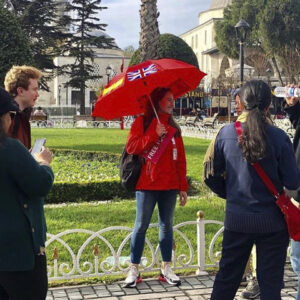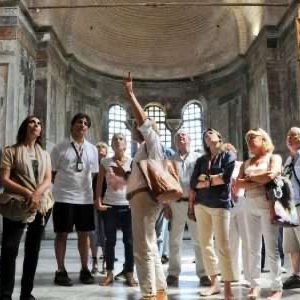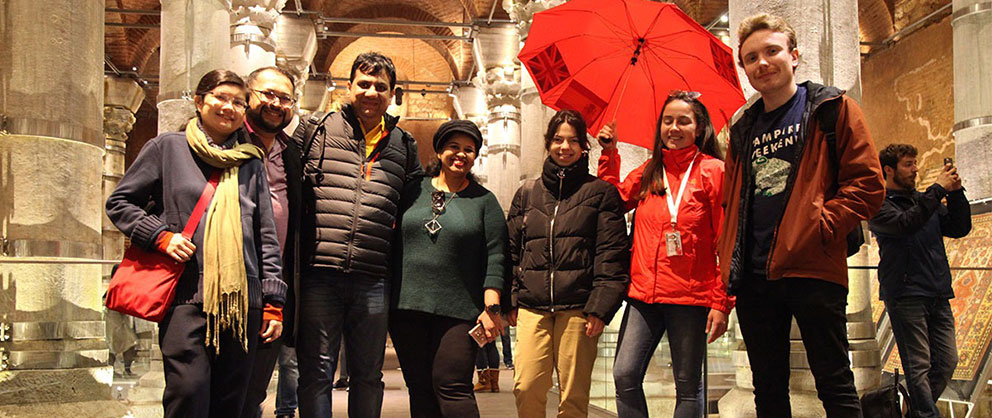The Fountain of Laecanius Bassus Hydrekdocheion: The Water Palace of Ephesus
In the southwest corner of the State Agora lie the remains of an imposing fountain known as the Fountain of Laecanius Bassus, also called the “Water Palace.” Constructed between 80 and 82 AD by order of Gaius Laecanius Bassus, governor of Ephesus, this fountain stands as a testament to architectural sophistication and the importance of water in the life of the city.
History and Construction of the Fountain
The Fountain of Laecanius Bassus was commissioned during the governorship of Gaius Laecanius Bassus and was intended to beautify the city while serving as an essential water source for its inhabitants. According to inscriptions found at the site, the fountain was notable not only for its functionality but also for its architectural magnificence.
The Significance of Governor Bassus
Gaius Laecanius Bassus was an influential governor in Ephesus. During his tenure, he promoted various public works, with the construction of this fountain being one of his greatest contributions to urban development and the city’s prestige.
Design and Architecture
The fountain’s façade was richly decorated and consisted of two stories facing the street, presenting an impressive visual spectacle. Statues of muses and tritons, which once adorned the fountain, reflect the connection between water and mythology in Roman culture. These sculptures, now displayed in the Ephesus Museum, stand as evidence of the artistic skill of the era.
A Monumental Design
- The main structure has a semicircular shape, a common design for Roman monumental fountains.
- It was connected to another fountain at the front and a storage cistern, ensuring a constant water supply.
- The grand size and rich decoration of the fountain earned it the name “Water Palace.”
Modifications and Restorations
During the reigns of Constantine and Constantius, the fountain underwent repairs, and wings were added to the original structure. These modifications highlight the continued importance of the fountain over the centuries and its adaptation to the city’s evolving needs.
The Nymphaion
The Fountain of Laecanius Bassus is also referred to as the Nymphaion, according to inscriptions from the era. This term, referring to fountains dedicated to nymphs, reinforces the symbolic connection of this structure with water as a vital and sacred element.
Archaeological Discoveries
Numerous statues and decorative elements were uncovered during excavations at the site. The statues of muses and tritons are among the most notable finds and are now part of the collection at the Ephesus Museum. These artifacts provide a fascinating glimpse into the aesthetics and iconography of the time.
The Ephesus Museum
The statues recovered from the fountain allow museum visitors to explore the symbolism and artistic prowess that characterized Roman public works. Each piece tells a story about the importance of water and its relationship to mythology.
Cultural Significance of the Fountain
The Fountain of Laecanius Bassus was not just a functional resource but also a symbol of power and prestige. Its monumental design and strategic location in the State Agora reflect its central role in the public life of Ephesus.
A Community Hub
In addition to being a water source, the fountain served as a gathering place for the people of Ephesus. Its rich decoration and imposing presence contributed to civic pride and the city’s cultural identity.
Tips for Visiting the Fountain of Laecanius Bassus
- Location: Southwest corner of the State Agora within the archaeological complex of Ephesus.
- Best time to visit: Early morning or late afternoon to avoid the heat and enjoy better lighting for photography.
- Respect the site: Avoid touching the structures or archaeological elements to help preserve this invaluable monument.
Conclusion
The Fountain of Laecanius Bassus is a symbol of the architectural and cultural grandeur of Ephesus. Known as the “Water Palace,” this impressive structure combines functionality, art, and symbolism, highlighting the importance of water in the daily and spiritual life of the city. Visiting this monument is a unique opportunity to immerse yourself in the history of Ephesus and admire the sophistication of Roman engineering and design.












3 thoughts on “The Fountain of Laecanius Bassus Hydrekdocheion”
★★★★★
Learning about and visiting ‘The Fountain of Laecanius Bassus Hydrekdocheion’ was both fun and educational. Everyone should experience this!
★★★★★
Highly recommend visiting ‘The Fountain of Laecanius Bassus Hydrekdocheion’—a site rich with history and unparalleled beauty.
★★★★★
Looking for an authentic and enriching experience? ‘The Fountain of Laecanius Bassus Hydrekdocheion’ is the place to be! Absolutely worth the visit.